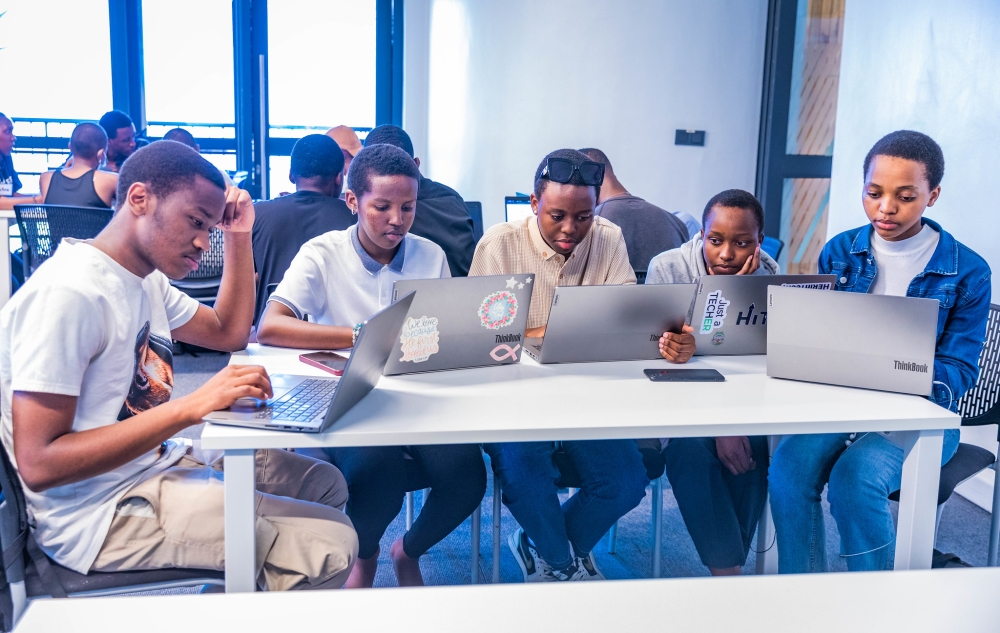

Rwanda is implementing a scheme to train one million coders under the second National Strategy for Transformation (NST2), a five-year government programme that runs from 2024 through 2029.
The target is expected to be attained through One Million Coders (OMC) programme, a partnership of the Government of Rwanda and the Government of the United Arab Emirates (UAE) aiming to enhance digital literacy among one million young Rwandans through six to seven-week online programming courses.
ALSO READ: ICT: Rwanda rolls out plan to train one million coders
Below are eight things you need to know about the programme, according to information The New Times got from the Ministry of ICT and Innovation (MINICT).
Addressing the digital skills gap
The One Million Coders initiative, MINICT indicated, aims to bridge the digital skills gap in today's rapidly advancing technological world, offering an alternative to traditional learning methods that often rely on the availability of a sufficient number of ICT teachers nationwide.
Its primary goal is to close the digital skills gap by equipping individuals with fundamental coding and technological competencies, ensuring that people from all backgrounds can contribute to and benefit from the evolving digital economy.
"This programme supports Rwanda’s efforts to develop a workforce capable of thriving in an information-driven future, aligning with the country’s vision to become a knowledge-based economy. By providing coding skills, the initiative also fosters innovation, entrepreneurship, and access to high-paying jobs in tech sectors, ultimately contributing to national development goals, Minister of ICT and Innovation, Paula Ingabire, told The New Times.
Requirements for one to get trained
The training is open to anyone with access to a device (such as a smartphone, laptop, or tablet) and internet connection. There are no stringent prerequisites regarding prior experience or qualifications, "so anyone with the motivation to learn coding is welcome.”
Ingabire pointed out that "the program is designed with inclusivity in mind, allowing individuals from all backgrounds to participate”. To earn certification, participants must complete the full training program.
Program timeline
The programme officially began with the release of the OMC platform on September 2, 2024. It is scheduled to run for three years, concluding on August 31, 2027.
MINICT observed that this timeline provides ample time for individuals to enrol, learn, and complete the various coding courses offered through the initiative.
ALSO READ: Rwanda Coding Academy set to accommodate more students
Source of funding
The programme is primarily funded by the Government of the United Arab Emirates (UAE) and implemented by the Ministry of ICT and Innovation.
These partners are committed to supporting digital capacity-building in Rwanda, ensuring that the necessary resources, platforms, and infrastructure are available to make the initiative a success.
Modalities for offering training
The training will be delivered entirely online through the One Million Coders platform (accessible at minict.gov.rw). Courses are self-paced, designed to be completed within an eight-week timeframe.
However, depending on the learner’s dedication and prior knowledge, the courses can be completed in as little as six weeks. This flexible model allows participants to learn at their own speed while balancing other commitments, such as school or work, MINICT indicated.
Focus on youth empowerment
While the initiative focuses on empowering young people, it is open to anyone aged 13 and above, recognising the importance of digital literacy for all age groups.
"By engaging younger participants, the programme aims to nurture a new generation of tech-savvy individuals who can shape Rwanda’s digital future,” Ingabire said.
However, the inclusivity of the programme ensures that adults who may wish to reskill or upskill can also benefit, making it a valuable resource for a broad segment of the population, she added.
What the program means for Rwanda
The One Million Coders program is a significant step toward Rwanda’s long-term vision of becoming a knowledge-based economy, Ingabire remarked.
As the country pushes toward achieving the goals outlined in its National Strategy for Transformation (NST2), she said, this initiative will play a key role in building a skilled workforce capable of driving innovation and economic growth.
"By producing one million coders, Rwanda will be well-positioned to create more tech jobs such as software development, artificial intelligence, and digital entrepreneurship, strengthening its regional and global competitiveness,” she observed
Additionally, she said, the programme contributes to Rwanda’s goal of fostering social and economic inclusion by providing opportunities for individuals to participate in the digital economy, regardless of their socio-economic background.
Courses covered
The programme offers three courses; Android Developer Fundamentals, Data Analysis Fundamentals and Programming Fundamentals.
Android Developer Fundamentals track aims to teach you the core fundamentals of Android development, how app layouts are created, how interactions with the users take place, and the basics of Kotlin, a language designed especially with speed in mind. It compiles faster, makes your application more lightweight, and prevents them from increasing in size.
Data Analysis Fundamentals aims to teach you the core fundamentals of Data Analysis and refine your ability to work with messy, complex datasets. You’ll learn to manipulate and prepare data for analysis and create visualizations for data exploration. Finally, you’ll learn to use your data skills to tell a story with data.
Regarding the Programming Fundamentals track, it is intended to teach the learner the core fundamentals of web development, how web pages are structured from scratch using a language called HyperText Markup Language (HTML), how this HTML structure is then designed and styled using another language called Cascading Style Sheets (CSS) and finally, how this styled structure gets converted into an interactive application using JavaScript (JS).


